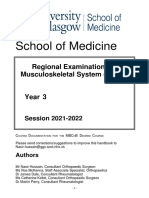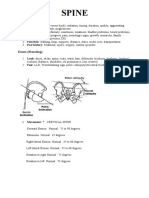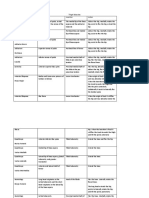0 ratings0% found this document useful (0 votes)
37 viewsE D Group Project
E D Group Project
Uploaded by
api-414772091This document describes a case involving a patient with shoulder pain. It lists working diagnoses of subacromial impingement, labral tear, rotator cuff tear/tendinopathy, and thoracic outlet syndrome. Objective assessment includes tests of posture, tissue characteristics, range of motion, strength, and special tests to evaluate the suspected diagnoses. The results of the objective assessment would be used to rule in or rule out the potential pathologies.
Copyright:
© All Rights Reserved
Available Formats
Download as DOCX, PDF, TXT or read online from Scribd
E D Group Project
E D Group Project
Uploaded by
api-4147720910 ratings0% found this document useful (0 votes)
37 views2 pagesThis document describes a case involving a patient with shoulder pain. It lists working diagnoses of subacromial impingement, labral tear, rotator cuff tear/tendinopathy, and thoracic outlet syndrome. Objective assessment includes tests of posture, tissue characteristics, range of motion, strength, and special tests to evaluate the suspected diagnoses. The results of the objective assessment would be used to rule in or rule out the potential pathologies.
Original Title
e d group project
Copyright
© © All Rights Reserved
Available Formats
DOCX, PDF, TXT or read online from Scribd
Share this document
Did you find this document useful?
Is this content inappropriate?
This document describes a case involving a patient with shoulder pain. It lists working diagnoses of subacromial impingement, labral tear, rotator cuff tear/tendinopathy, and thoracic outlet syndrome. Objective assessment includes tests of posture, tissue characteristics, range of motion, strength, and special tests to evaluate the suspected diagnoses. The results of the objective assessment would be used to rule in or rule out the potential pathologies.
Copyright:
© All Rights Reserved
Available Formats
Download as DOCX, PDF, TXT or read online from Scribd
Download as docx, pdf, or txt
0 ratings0% found this document useful (0 votes)
37 views2 pagesE D Group Project
E D Group Project
Uploaded by
api-414772091This document describes a case involving a patient with shoulder pain. It lists working diagnoses of subacromial impingement, labral tear, rotator cuff tear/tendinopathy, and thoracic outlet syndrome. Objective assessment includes tests of posture, tissue characteristics, range of motion, strength, and special tests to evaluate the suspected diagnoses. The results of the objective assessment would be used to rule in or rule out the potential pathologies.
Copyright:
© All Rights Reserved
Available Formats
Download as DOCX, PDF, TXT or read online from Scribd
Download as docx, pdf, or txt
You are on page 1of 2
E&D Project Case 3:
1. Working Diagnoses and Rationale:
Subacromial Impingement (age, hx of overhead athlete, dominant shoulder, deep
pain, reaching in the back pocket/overhead increases his symptoms)
Labral Tear (Possibly a SLAP tear): (peel back mechanism, deep pain, active with
arm and increased pain with compression, such as applying pressure through his
arms when he’s on his hands and knees)
Rotator cuff tear/tendinopathy: (athlete, overhead, referral pattern, deep pain, age)
TOS: (overhead/ repetitive→ pain, pain changes with posture head extension
leads to symptoms)
2. Objective Information/Tests & Measures
Posture/Inspection: See if their habitual posture could contribute to tissue stresses/pain
Swelling: the location of the swelling can indicate inflammation of certain
muscles or TOS if the arm was “puffy”
Tissue color: look for pallor indicates TOS
Atrophy of supraspinatus and infraspinatus, scapula position, look for forward
head posture
Upper Quarter Screen: Perform this to rule out any neurological involvement. TOS may
also involve neurological abnormalities in this screen due to brachial plexus compression
Palpation: Note any changes in the tissue or provoke the patient’s pain with palpation
Bony Prominences: coracoid process, greater and lesser tubercles of humerus,
Soft Tissue: Supraspinatus, infraspinatus tendons and muscle belly. Long head of
the biceps tendon.
Tissue temperature: TOS or inflammation of the tissue could increase the
temperature.
Scapulothoracic rhythm, including scapular dyskinesis. This could tell us if their UE
functions normally
ROM: To see if there are any limitations to movement or if certain movements provoke
symptoms or pain.
Shoulder abduction, adduction, flexion, IR, ER, horizontal adduction
Painful arc of motion
Joint play Assessment of GHJ and Scapulothoracic Joints: Check to see if they have
hyper/hypo-mobility or pain. Note if pt is muscle guarding during assessing joint play, or
we might feel crepitus, clicking, catching, grinding (indicates labral tear).
MMT: Perform this to see if there is muscle weakness or provokes pain/symptoms.
RTC muscles (rule out Rotator cuff tear). Bicep for labral/impingement. Deltoid,
traps, serratus anterior tests force coupling of the shoulder important for
impingement.
Special Tests: Each of these categorized diagnoses will help us rule in or rule out the
suspected pathology to provoke the suspected pathological tissue.
Impingement Special Tests: Neer’s compression test, Hawkins/ Kennedy
impingement test, coracoid impingement, cross-arm test.
Labral Tear (SLAP): Obrien’s test, Biceps Load test, Crank test
Rotator cuff tear: Empty can/full-can test/Drop arm test (Supraspinatus), Lag
signs (infraspinatus; supraspinatus).
TOS: Adson’s test, Allen’s test, Wright’s test, Costoclavicular syndrome test.
Exam and Diagnosis II: Case 4
Working Diagnoses and Rationale:
Lumbar Radiculopathy (suspected at L4-S1 and could be a HNP): neurological symptoms in
LE that occasionally travels down her entire leg to lat. lower leg. Pain can be relieved with
rest lying supine or right trunk SB. Pt has pain in the lower back.
Piriformis Syndrome/Sciatic Nerve Compression: sensory supply of the sciatic nerve could
be felt in the anterior/posterior leg, and sole/dorsum of foot. She’s a runner and her running
gait pattern could either contract or stretch the piriformis compressing the sciatic nerve.
Plantar fasciitis: rule in or rule out since the doctor has prescribed this diagnosis and pt has
pain on plantar and dorsum lateral portion of foot. Her activity level and running routine may
be stressing the plantar fascia and not allowing adequate rest/healing.
Objective information/Test & Measures
Posture/Inspection: their frequent/preferred postures could put stress on their lumbar spine or
feet. Pt’s posture could also tell you if they are shifting away from pain in the case of a
herniation leading to a radiculopathy. Check: iliac crests, lumbar lordosis, pelvic tilt, leg
length, pes planus/cavus, supination/pronation (too many toes sign). Look at shoes/calluses to
see where they are putting stress on their feet.
Lower Quarter screen: Perform this to rule out any neurological involvement and determine
if sensory loss is in a dermatomal pattern (L4, L5, S1) or peripheral nerve distribution (sciatic
nerve).
Gait: This can tell us about stresses she is putting on her body throughout normal activity.
Observe step length, check running form since she is continuing with this activity, Toe in/toe
out, limping, Dynamic knee valgus, pronation (plantar fasciitis)
Palpation: tenderness/pain of piriformis or provoke neurological symptoms, tenderness/pain
at medial calcaneus or plantar fascia (plantar fasciitis), TTP at greater trochanter for
piriformis insertion.
Joint Play Assessment: Lumbar vertebra springing may provoke pain.
ROM: Note any limitations to movement or if certain movements provoke symptoms or pain.
Trunk forward bending, backward bending, rotation, sidebending. H and I testing for their
lumbar spine. Hip flexion, extension, ER, IR.
Muscle Length Testing: Hamstring length can contribute to LBP (SLR and 90/90 test),
gastroc/soleus can be tight with plantar fasciitis
MMT: We would perform to see if there is weakness or provokes pain/symptoms. This could
also help support myotomal weakness (nerve root pathology) or show muscle weakness due
to a peripheral nerve. MMT Piriformis, hamstrings, gastroc/soleus, tibialis anterior/posterior
Special tests: Each of these categorized diagnoses will help us rule in or rule out the
suspected pathology to provoke the suspected pathological tissue.
o Lumbar radiculopathy: Compression test, Distraction test, slump test, Straight leg
raise, Heel Walking/Toe walking: Toe walking is a S1 nerve root problem if they are
unable to perform, heel walking can be L4/L5 nerve root issue if they cannot perform.
(Heel walking would be painful for plantar fasciitis)
o Piriformis syndrome: Piriformis syndrome test.
o Plantar Fasciitis: Windlass Test: PT performs passive Great Toe Extension. Plantar
fascia becomes tight when big toe extends. Pain could be provoked with plantar
fasciitis
You might also like
- DR Kakaza Lectures and Ward Round Notes - 0220Document61 pagesDR Kakaza Lectures and Ward Round Notes - 0220sun108100% (1)
- Clinically Oriented Anatomy Blue BoxesDocument19 pagesClinically Oriented Anatomy Blue Boxeschrismd465100% (4)
- Hip ExaminationDocument84 pagesHip ExaminationDeepak Kumar100% (1)
- Muscles Within Muscles Coordination of 1Document17 pagesMuscles Within Muscles Coordination of 1luiz henrique matiasNo ratings yet
- GALS Examination OSCE GuideDocument10 pagesGALS Examination OSCE GuideSandarekha PereraNo ratings yet
- Applied Functional Science Afs PPDocument9 pagesApplied Functional Science Afs PPapi-414772091No ratings yet
- Compensation For Organ DonationDocument14 pagesCompensation For Organ Donationapi-414772091No ratings yet
- 3 Back and Joints March 2011Document19 pages3 Back and Joints March 2011suaqaziNo ratings yet
- Rheumatology Examination: Physical Examination-N ManoliosDocument7 pagesRheumatology Examination: Physical Examination-N ManoliosRohit SharmaNo ratings yet
- Clinical Signs and TestsDocument7 pagesClinical Signs and Testsmail2mohsinaliNo ratings yet
- Examination of The Joints and ExtremitiesDocument66 pagesExamination of The Joints and Extremitiesapi-25914483No ratings yet
- Week 10 PCP Workbook QsDocument4 pagesWeek 10 PCP Workbook Qsapi-479849199No ratings yet
- Spine Exam Lecture - Shaffer 2006Document65 pagesSpine Exam Lecture - Shaffer 2006মোহাম্মদ আবীরNo ratings yet
- Pengkajian MuskuloskeletalDocument35 pagesPengkajian MuskuloskeletalDEA ZUBAIDAHNo ratings yet
- Acute Low Back PainDocument39 pagesAcute Low Back PainSathish KumarNo ratings yet
- 02.elbow PainDocument62 pages02.elbow PainKhushboo IkramNo ratings yet
- Lower Limb Neurological Examination OSCE GuideDocument15 pagesLower Limb Neurological Examination OSCE GuideLeen abusarhanNo ratings yet
- Approach To A Patient With Low Back Ache: DR - Ankur BatraDocument104 pagesApproach To A Patient With Low Back Ache: DR - Ankur BatraAnkur Batra100% (1)
- Clinical Signs NamedDocument25 pagesClinical Signs NamedRapur SivaprasadNo ratings yet
- Lower Limb Neurological Examination OSCE GuideDocument7 pagesLower Limb Neurological Examination OSCE GuideKeen RunnerNo ratings yet
- Low Back PainDocument100 pagesLow Back Painchandrusai100% (2)
- Elbow Examination: Subjective HistoryDocument2 pagesElbow Examination: Subjective HistoryshikhaNo ratings yet
- Book Reading Koas Ortho 1-6jun09Document267 pagesBook Reading Koas Ortho 1-6jun09Eka Yoga WiratamaNo ratings yet
- Lec7 Assessment of SpineDocument35 pagesLec7 Assessment of Spinesana mumtazNo ratings yet
- Medicine 2.3c Reflex TestingDocument5 pagesMedicine 2.3c Reflex TestingelleinasNo ratings yet
- Sacroiliac Joint Dysfunction and Piriformis Syndrome PDFDocument37 pagesSacroiliac Joint Dysfunction and Piriformis Syndrome PDFDevi SiswaniNo ratings yet
- Lower Extremity Amputation #8Document7 pagesLower Extremity Amputation #8Mary StrangeNo ratings yet
- Approach To Low Back Pain (22 Oct)Document61 pagesApproach To Low Back Pain (22 Oct)Halawatul ImanNo ratings yet
- REMS Booklet For Y3 Students - 2021-22Document11 pagesREMS Booklet For Y3 Students - 2021-22AmaNo ratings yet
- 0 - Knee Joint AssessmentDocument4 pages0 - Knee Joint AssessmentAndrei MariusNo ratings yet
- Peat 1.2 PDFDocument16 pagesPeat 1.2 PDFArchita AgarwalNo ratings yet
- Spine: HistoryDocument6 pagesSpine: HistorySham SundarNo ratings yet
- Case 3Document2 pagesCase 3api-510596962No ratings yet
- 1-5-22 OMM Repro Considerations MasterDocument67 pages1-5-22 OMM Repro Considerations MasterTanner HancockNo ratings yet
- Resume Manual TherapyDocument58 pagesResume Manual Therapynabila nur afifah fitriNo ratings yet
- Physical Examination ChecklistDocument17 pagesPhysical Examination ChecklistbelloNo ratings yet
- L2-L4 Myotome L2 - L4 Myotome L4 L1 - L3 L4: Squat TestDocument4 pagesL2-L4 Myotome L2 - L4 Myotome L4 L1 - L3 L4: Squat Testapi-479754549No ratings yet
- Manual TherapyDocument16 pagesManual TherapylecturioNo ratings yet
- Dermatomes and MyotomesDocument19 pagesDermatomes and MyotomesDaniela N Anghel100% (1)
- Week 4 Case 4 Chir13009Document9 pagesWeek 4 Case 4 Chir13009api-479720222No ratings yet
- Joint ExaminationsDocument6 pagesJoint Examinationsjoelh9No ratings yet
- Student Ortho OscevDocument17 pagesStudent Ortho OscevMuradNo ratings yet
- Week 4Document5 pagesWeek 4api-479499469No ratings yet
- Hip PT AssessmentDocument57 pagesHip PT Assessmentkrissh20No ratings yet
- Done By: Team Leader:: Rawan Altaleb Khulood AlraddadiDocument6 pagesDone By: Team Leader:: Rawan Altaleb Khulood Alraddadishagufta lailaNo ratings yet
- Exam KneeDocument11 pagesExam KneesingwongcsNo ratings yet
- 5.PT for Lumbar Spine 2 )Document51 pages5.PT for Lumbar Spine 2 )zeyad ismailNo ratings yet
- Station 1: Nerve Tension TestsDocument8 pagesStation 1: Nerve Tension TestsRNo ratings yet
- Neurological History and ExaminationDocument30 pagesNeurological History and ExaminationMaria Agatha100% (1)
- Spine ExaminationDocument46 pagesSpine ExaminationRatish Mishra100% (1)
- David Butler Neural Tissue Mobilisation-1Document11 pagesDavid Butler Neural Tissue Mobilisation-1Himani BhondgeNo ratings yet
- Clinical Examination of The Knee: DR John EbnezarDocument95 pagesClinical Examination of The Knee: DR John EbnezarsandeepNo ratings yet
- Standardized Patient Lower Extremity ExamDocument4 pagesStandardized Patient Lower Extremity ExamapnipatNo ratings yet
- Motor ExaminationDocument40 pagesMotor ExaminationBinte Muhammad100% (1)
- Week 6Document8 pagesWeek 6api-479499469No ratings yet
- The Examination of The Knee - 040716Document35 pagesThe Examination of The Knee - 040716Mufidah FidaNo ratings yet
- Assessing The Knee JointDocument15 pagesAssessing The Knee Jointapi-595122187No ratings yet
- Objective Assessment of The FootDocument4 pagesObjective Assessment of The FootAndy TsuiNo ratings yet
- Draft 1Document33 pagesDraft 1RasYa DINo ratings yet
- Hip Arthroscopy-2Document6 pagesHip Arthroscopy-2jkfkongNo ratings yet
- Approach To Backache 2022Document31 pagesApproach To Backache 2022Adenly MaayNo ratings yet
- Spine ExaminationDocument30 pagesSpine ExaminationNadia Salwani100% (1)
- Exit Interview Questions 2020Document5 pagesExit Interview Questions 2020api-414772091No ratings yet
- Professional Behaviors Assessment 2020Document14 pagesProfessional Behaviors Assessment 2020api-414772091No ratings yet
- Article Critique 1Document2 pagesArticle Critique 1api-414772091No ratings yet
- PWR Moves PresentationDocument11 pagesPWR Moves Presentationapi-414772091No ratings yet
- Article 1 Critique FeedbackDocument1 pageArticle 1 Critique Feedbackapi-414772091No ratings yet
- PICO #1 & Search Strategy Worksheet: Name: Taylor MillsDocument4 pagesPICO #1 & Search Strategy Worksheet: Name: Taylor Millsapi-414772091No ratings yet
- Certificateofcompletionnew HipaaDocument1 pageCertificateofcompletionnew Hipaaapi-414772091No ratings yet
- Objective Balance Scale PresentationDocument9 pagesObjective Balance Scale Presentationapi-414772091No ratings yet
- Cannabidiol CBD Oil PresentationDocument10 pagesCannabidiol CBD Oil Presentationapi-414772091No ratings yet
- Physical Therapy Resume JanDocument2 pagesPhysical Therapy Resume Janapi-414772091No ratings yet
- Hipaacertificate 224347Document1 pageHipaacertificate 224347api-414772091No ratings yet
- Certificate of Participation For Ptso 2019Document1 pageCertificate of Participation For Ptso 2019api-414772091No ratings yet
- Academic History July 2019Document3 pagesAcademic History July 2019api-414772091No ratings yet
- First Year Ptso CertificateDocument1 pageFirst Year Ptso Certificateapi-414772091No ratings yet
- Studentcertificate CPR CardDocument1 pageStudentcertificate CPR Cardapi-414772091No ratings yet
- The Importance of A Warm Up and Cool DownDocument2 pagesThe Importance of A Warm Up and Cool DownJuveria NawazNo ratings yet
- ACL Case StudyDocument14 pagesACL Case StudyKate Crizia VillafuerteNo ratings yet
- Neural Control of MasticationDocument34 pagesNeural Control of MasticationAnonymous k8rDEsJsU10% (1)
- Palmassager Handheld Massager Catalog RedactedDocument1 pagePalmassager Handheld Massager Catalog RedactedAl BnNo ratings yet
- SMB Thigh Muscles WorksheetDocument3 pagesSMB Thigh Muscles WorksheetShehryar BaigNo ratings yet
- Genu ValgumDocument2 pagesGenu ValgumBilly SangpengendaramerahNo ratings yet
- Spine Structure and FunctionDocument19 pagesSpine Structure and Functionakhil dattaNo ratings yet
- Surgey MCQSDocument95 pagesSurgey MCQSZain HadiNo ratings yet
- Postures of Shibashi: Lesso NDocument34 pagesPostures of Shibashi: Lesso NBOSSMEYJNo ratings yet
- Evaluation of Butox Injuction in Equine DeformityDocument6 pagesEvaluation of Butox Injuction in Equine DeformityShauki AliNo ratings yet
- TB Stretch Strap Manual For Fitness or Yoga Movements.Document2 pagesTB Stretch Strap Manual For Fitness or Yoga Movements.No EezeeNo ratings yet
- Mechanical Properties of Lumbar Spine Motion Segments Under Large LoadsDocument6 pagesMechanical Properties of Lumbar Spine Motion Segments Under Large LoadsMike Vandumurugan100% (1)
- Osseous Fixation Pathways in Pelvic and Acetabular Fracture Surgery Osteology, Radiology and Clinical Applications 2011Document8 pagesOsseous Fixation Pathways in Pelvic and Acetabular Fracture Surgery Osteology, Radiology and Clinical Applications 2011Gonzalo JimenezNo ratings yet
- Adeel Assignment No 2Document7 pagesAdeel Assignment No 2Adeel AfzalNo ratings yet
- 109-Article Text-170-1-10-20190525Document5 pages109-Article Text-170-1-10-20190525inesNo ratings yet
- (1479683X - European Journal of Endocrinology) ENDOCRINOLOGY and ADOLESCENCE - Osteoporosis in Children - Diagnosis and ManagementDocument13 pages(1479683X - European Journal of Endocrinology) ENDOCRINOLOGY and ADOLESCENCE - Osteoporosis in Children - Diagnosis and Managementtamaz takidzeNo ratings yet
- Tha ProtocolDocument7 pagesTha ProtocolJosephine SaesariaNo ratings yet
- Posttraumatic Delayed Vertebral CollapseDocument9 pagesPosttraumatic Delayed Vertebral CollapseLavinia PascuNo ratings yet
- Gradual Correction of Knee Flexion Contracture Using External FixationDocument6 pagesGradual Correction of Knee Flexion Contracture Using External Fixationeka aningNo ratings yet
- Solar ElbowDocument22 pagesSolar ElbowMihaela HerghelegiuNo ratings yet
- Anatomy of MovementDocument20 pagesAnatomy of MovementGytis AntanavičiusNo ratings yet
- Pilates and The Powerhouse IDocument10 pagesPilates and The Powerhouse Imatsoki100% (1)
- 25 Congenital Scoliosis (Dr. Fazl Karam)Document45 pages25 Congenital Scoliosis (Dr. Fazl Karam)Dev ZunigaNo ratings yet
- Locomotion and MovementDocument3 pagesLocomotion and MovementYouTutor PSNo ratings yet
- MSK PaperDocument4 pagesMSK PaperAHMAD AliNo ratings yet
- FlowChart - Systematically Attacking The Guard by Gordon RyanDocument1 pageFlowChart - Systematically Attacking The Guard by Gordon RyanAnte Bosancic45% (11)
- Norma BasalisDocument10 pagesNorma BasalisArshad hussainNo ratings yet
- Closed Fracture 1/3 Distal Left Tibia Et FibulaDocument21 pagesClosed Fracture 1/3 Distal Left Tibia Et FibulaHaidir MuhammadNo ratings yet










































































































